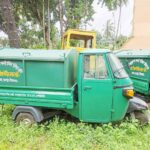MT Desk: Semporna, a remote town on the northern tip of Borneo, is famous for some of Malaysia’s most stunning dive sites and marine life, but for the past few years the fame has been fading with plastic litter smothering the shoreline.
Plastic pollution is one of the most pressing environmental issues. Production of disposable plastic products has rapidly increased in the past two decades, overwhelming the world’s ability to deal with them.
Over 380 million tons of plastic are produced globally every year, with nearly half of it being single-use plastic, or plastic disposed of after use, like bags or food packages. While less than 10 percent of plastic gets recycled, according to Plastic Oceans, some 10 million tons of it enters the oceans and may remain for 400 years before it decomposes.
In Semporna and other parts of the scenic state of Sabah, residents have watched their beaches and coral reefs gradually disappear wrapped in discarded plastic, and animals dependent on the ocean for sustenance poisoned and disfigured as they swallow the indigestible litter.
Aware of the conveniences plastics offer and the impossibility of phasing them out from our lives, students from the MARA Junior Science College in Semporna have come up with a way to counter the pollution problem: They decided to fight plastic with plastic — a different one, though, made from seaweed, that does not harm marine species.
“The students are the sons of Semporna, thus they have a sense of duty to protect and conserve the beautiful islands and marine lives there,” their biology teacher and project mentor, Shahrul Hafiz Abdul Ghani, told Arab News.
“They decided to use seaweed, which is an abundant natural resource in Semporna, and produce seaweed-based bioplastics such as straws and plastic bags … It is biodegradable and would reduce our dependency on plastics.”
Ghani’s team, comprising Fahim Nazhan, Muhammad Fauzan Lakarani and Muhammad Fauzi Lakarani, is using Kappaphycus, a genus of red algae that is common in Malaysian waters.
One of the fastest-growing organisms on Earth, seaweed is a sustainable material to use as a replacement for plastic packaging. It is biodegradable in about four to six weeks.
“Now we are at the stage of producing a better prototype to ensure it has the perfect durability and plasticity … There is a commercial potential for seaweed, and we are on the lookout for more funding for our bioplastic,” Ghani said, adding that his students are going to present their prototype seaweed plastic bags, utensils and straws this year.
The only major drawback to producing seaweed-based bioplastic is currently its cost, as processing technologies have only been developed across the world in recent years.
Chung Ngin Zhun, who founded Malaysian seaweed startup Rhodomaxx four years ago, told Arab News that support for developing such initiatives was still too little for them to bloom.
“Many Malaysians are not aware of the potential usage of seaweed other than being used as nori for sushi. There have been initiatives by the government since 2018 to get rid of single-use plastics … There is a move towards that direction, but this kind of trend is usually set by the more affluent class of society. It is not really a holistic approach, maybe because of the lack of education,” he said.
Chung’s company is a pioneer in the Malaysian market, producing seaweed-based vegan leather, bioplastics, and mineral supplements. A Sabah native himself, he sources the raw material from the region and from neighboring Indonesia.
“It grows naturally without the use of land without the use of agricultural inputs and also without the use of freshwater, which makes it an ideal resource for a more sustainable future,” Chung said, but added that despite the abundance of seaweed, the industry will find it hard to grow locally.
“Unfortunately, there is a lack of narrative on this side of the world, the global south produces only raw materials … We don’t have the infrastructure to fund projects like ours, we also don’t have legislations and lawmakers that are aware of this sort of circular economy model and how to drive governmental programs to support initiatives such as ours.”
Another hindrance to the seaweed industry’s growth in Malaysia may be the consistency of supplies, according to Siti Nahdatul Isnaini Said Hussin, a scientist from National Institutes of Biotechnology Malaysia.
“The current rate of production at Sabah coastal areas is not promising enough to ensure sustainable sources of seaweed supplies for commercial bioplastic production,” she said, adding that cultivation cycles have been disturbed by plant diseases and grazers such as turtles or milkfish that feed on seaweed.
On the other hand, the seaweed that is farmed in the region has regular foreign buyers, mainly from China, who offer higher prices to growers than the local market.
The development of seaweed bioplastics in Malaysia could, in Hussin’s opinion, be more successful if it were linked to the material’s other properties, especially its edibility and appeal as a halal product to consumers in the Muslim-majority country.
“The future of seaweed-based bioplastics could be more promising by focusing on the strength of the seaweed itself — its high nutrition content, edible and water-soluble anti-inflammatory properties,” she said.
“Halal encapsulation, edible food sachets, and other applications of bioplastics related to food would be more attractive and marketable.”





